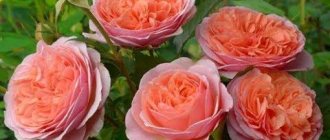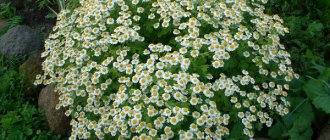| Place | Name | Characteristics in the rating |
| The best varieties of floribunda roses for Siberia |
| 1 | Home and Garden | Better endurance and unpretentiousness |
| 2 | Gartenfreude | Self-cleaning ability |
| 3 | Solero | Resistant to fungal diseases |
| The best climbing varieties of roses for Siberia |
| 1 | Rosarium Jutersen | The most popular variety. Excellent aroma. Incredible pomp |
| 2 | Jasmine | An excellent combination of beauty and frost resistance |
| 3 | Swan Lake | Strong odor |
| The best hybrid tea varieties of roses for Siberia |
| 1 | Black magic | Better resistance to external factors |
| 2 | Blue Moon | Fast adaptation |
| 3 | Red Intuition | Best price. No thorns |
| 4 | Osiana | Soft color. Long stems |
What is winter hardiness and how is it determined?
Winter hardiness is the ability of plants to withstand various environmental factors in the autumn-spring period. Winter hardiness includes some concepts: cold resistance is a characteristic of a variety that gives it the ability to withstand low positive temperatures from +0 to +10°C, frost resistance is a determinant of the ability of plants not to die at low negative temperatures.
Winter hardiness is a trait responsible for the viability of a rose in areas with harsh climatic conditions, the ability to withstand a whole range of unfavorable conditions. Among them:
- sudden temperature changes;
- return frosts;
- icing;
- snow and wind load;
- prolonged thaws;
- winter dryness.
This indicator primarily depends on genetic predisposition, but can also change due to the conditions of the summer growing season.
Good weather in summer:
- sufficient rainfall;
- optimal humidity;
- sunlight;
- heat stimulates excellent growth and full development;
- and also affect the degree of color stability.
When choosing a variety, it is advisable to focus on local species of roses adapted to given climatic conditions.
This is interesting: Rosa Westerland - planting and caring for a park species
General recommendations
Despite the fact that these varieties of roses can be called real "Spartans", still not a single plant will survive without shelter when the thermometer shows -20-30°C or lower. Take care of winter shelter, even if the rose is very winter-hardy.
There is a shortage of sun in Siberia. Therefore, it is better to plant a climbing rose on the south side, but not in an open area (in summer the flowers can fade in the sun, and in winter they can suffer from strong winds).
Now you know about the 5 best varieties of climbing roses for the Siberian region. Choose any one, decorate your site with these luxurious plants. And you can enjoy their aroma and luxurious flowers every summer without any unpleasant surprises!
Review of floribunda roses for growing in Siberia
Floribundas bloom actively in Siberian gardens in sunny areas protected from the wind.
The floribunda group is a hybrid of hybrid tea and polyanthus roses. These are very spectacular bush plants with lush flowering. Each raceme can develop up to 10-15 flowers.
The great advantage of floribundas is their genetic winter hardiness. The right rootstock consolidates and enhances this quality. Based on this, roses of the floribunda group can be recommended for testing in Siberian conditions. The following varieties are promising:
- Arthur Bell - low bushes up to 80 cm in height, with abundant semi-double flowers of yellow-pink color. Under active sun, flowers can fade to a creamy shade.
- Jack Frost - bushes up to 70 cm in height, covered with densely double snow-white flowers, resistant to rain. The aroma is strong. Suitable for forcing in winter.
- Salzburg - bushes up to 120 cm in height, with frost resistance down to -350C. Flowers in large inflorescences, coral in color, with excellent resistance to rain. The only drawback of the variety is its susceptibility to powdery mildew.
- Evelyn Fison is an old exhibition variety of the floribunda group with a bush height of up to 80 cm. The flowers are red, double, with a light aroma, very resistant to rain. The bush can withstand frosts down to -300C and is not susceptible to powdery mildew and black spot.
Based on the practice of rose growers in Siberia, we can recommend the floribunda of the English selection Eyes For You . Despite the average winter hardiness (up to -250C with good shelter), this variety showed an increase in this indicator if planted in a group.
Luminion, or Rosie Mittermeier
Roses of this variety are famous for their bright fiery scarlet cup-shaped flowers, which are collected in branched inflorescences of 5-7 pieces. The color of the leaves is rich green with a glossy tint.
| Purpose | Plant height | Bloom | Aroma | Winter hardiness |
| 70 cm | Moderate, long | Easy | Medium, requires cover | |
Planting, care and cultivation
Despite the relatively simple care, the type of roses that creep along the ground requires compliance with a list of rules that will help create the most comfortable conditions for plants to grow and develop.
Read also: How to cook green peas
We plant ground cover roses on hills, in well-lit places, which are shaded during the peak of the midday heat. Otherwise, the rose may get burns to the leaves and petals. Also in lowlands, the bush may suffer from excess moisture, which can lead to rotting of the root system. An ideal option would be a raised flower bed or a hillock.
Plants love chernozem soils; light loamy soils are allowed. The soil reaction should be slightly acidic. It is quite simple to create conditions on the site, so even if you do not live in an area with chernozem soils, this is not a reason to refuse roses on the site.
If there were already roses in the selected area, then the soil will have to be carefully prepared. Flowers will not like alkalizing the soil; you will need to prepare a suitable substrate and plant the rose in a deep hole with completely prepared soil.
Pruning ground cover roses
If the rose bush was planted in the fall, there is no need to prune it in the spring. For an already established plant, pruning is carried out in the spring, at the beginning of the growing season, after the cover has been removed. Pruning itself comes down to cutting out dried, diseased shoots. A creeping bush requires minimal crown formation.
Total pruning completely rejuvenates the plant and makes further care much easier. However, this approach will require about six months for the rose to restore its green mass, and the area will look unsightly.
Video on pruning ground cover roses to help:
How to cover ground cover roses for the winter
In temperate climates, most ground cover roses tolerate wintering well without shelter, but in regions where severe frosts are possible, it is better to play it safe and provide shelter for the plants.
The shoots are covered with branches and spruce branches. Spruce branches can also be laid on the ground under rose vines to prevent rotting of the branches. To create a shelter with an air gap, dense fabric, lutrasil, or tarpaulin can also be used. The material can envelop the bush or be laid on agrofibre or metal arches.
Propagation of roses by cuttings
The most accessible method, even for a novice florist, is propagation by cuttings for ground cover roses. Also, these plants have the ability to take root with their stems during prolonged and close contact with the ground, which practically eliminates the need for the owner to wait for roots to appear.
Mature shoots are selected for cuttings. In most varieties they reach the thickness of a pencil. The exception is miniature varieties, where the thickness will be less.
For planting, a shoot of at least 3 internodes is selected. The cut is made under the lower bud. You need to carefully remove the lower leaves and thorns. The cuttings are immersed in a solution of a growth stimulator for 2 hours.
A shaded area is selected for rooting. Dig a hole or trench if there are multiple cuttings. Depth about 15cm. add sand to a third of the depth and plant the cuttings. The bud under the bottom leaf should be close to the ground. The distance between the cuttings is 15-20 cm. In the spring, the plants are transplanted to a permanent place.
Cuttings are one of the most popular methods. It is affordable and allows you to get several bushes at once. The most crucial moment is the formation of roots. Often the leaf buds are activated first and the gardener relaxes. At this stage, the gardener can relax and begin to water the cuttings too much, which leads to rotting. Keep the soil and sand moist, but don't overdo it. Use growth stimulants to increase the survival rate.
With the advent of hardy and frost-resistant varieties, growing roses became available in the gardens of Siberia. Here, the regional climate is somewhat harsh for the crop, so gardeners are required to have good knowledge and adherence to agricultural technology, careful selection of winter-hardy varieties and shelter for the winter.











